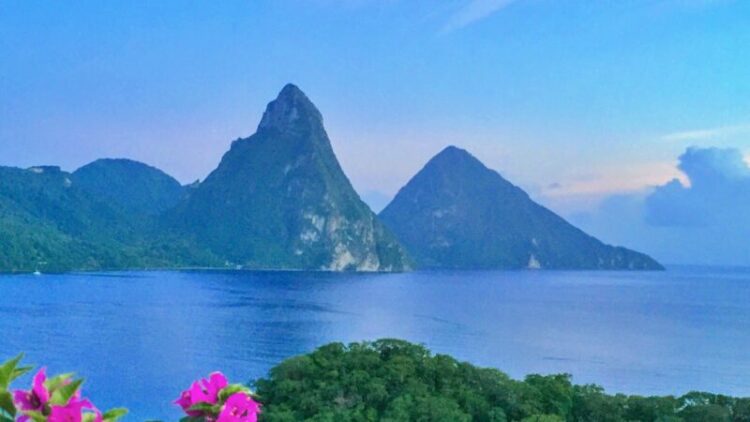The St. Lucia Pitons; photo via Canva Pro.
By Tyrell Gittens
This story is a combination of two articles that were first published on the Cari-Bois Environmental News Network. It appears below as part of a content-sharing agreement.
Representatives from one of Global Voices’ republishing partners, Cari-Bois Environmental News Network, are attending the 26th Congress of the Latin American and Caribbean Network of Environmental Funds (RedLAC) in St. Lucia, which takes place from October 7-10. This annual environmental finance event, being hosted for the first time in the Eastern Caribbean, strives to unite environmental funds from Latin America and the Caribbean with strategic allies and international partners, investors, and government representatives.
This year’s theme, “30x30x30: The Path to 2030,” aims to “[advance] global conservation targets within national and regional contexts.” It refers to the “30×30” conservation target, a key element of the recently adopted Global Biodiversity Framework (GBF), which mandates that 30 percent of the earth’s land and sea should be conserved by the year 2030 via the establishment of protected areas and the like.
In a recent interview, the chief executive officer of the Caribbean Biodiversity Fund (CBF), Karen McDonald Gayle, explained why the Congress is relevant to the Caribbean’s approach to the 30×30 target: “It’s very important that we make the voice of the Caribbean heard and more specifically, the voice of the Eastern Caribbean.” The day-to-day realities of aspiring to the United Nations’ Sustainable Development Goals and reaching these global targets are finally getting the opportunity to be discussed in the context of the Latin American and Caribbean experience.
As global conservation efforts focus on the implementation of Target 3 of the Kunming-Montreal Global Biodiversity Framework (GBF), RedLAC’s focus is on strengthening and expanding partnerships with the region’s implementing bodies. More than 200 attendees from 20 countries are participating.
In its country profile for St. Lucia, the Convention on Biological Diversity shares that the island is home to over 1,300 plant species, 160 birds, 250 reef fish, 50 coral species, and other endemic species like the St. Lucia parrot and St. Lucia whiptail lizard. The island’s high degree of biodiversity, as well as its international recognition as a biodiversity hotspot, serve as additional inspiration for attendees to continue investing in the protection of the region’s biodiversity.
Noting that the Congress will help strengthen relationships between regional environmental funds, Gayle added that the timing of the meeting is also significant, given that the 2024 United Nations Biodiversity Conference (COP16) will be in Cali, Colombia, a few weeks later: “[RedLAC] provides an invaluable platform to build and encourage a stronger presence of Caribbean countries in this network and to reinforce our collective message of long-term environmental funding for the region.”
RedLAC members have, therefore, been using the opportunity to do a “stock take” before COP16 and identify the progress made on supporting the implementation of the GBF’s target while also discussing potential areas of growth.
Since its establishment in 1999, RedLAC has been developing and implementing financial mechanisms to help address conservation efforts in the region. Given the high biodiversity of the countries in its network, RedLAC’s 32 members contribute to the protection of an estimated 50 percent of the world’s tropical forests, 41 percent of the world’s mammals, 33 percent of the total reptile species, and 50 per cent of the world’s birds and 30x30x30 impacts it all.
“It is very important that [we] come together to figure out the most holistic approach to working with governments in the region and ensuring that there’s funding available for the work,” Gayle said, “but we also have to communicate honestly about what our challenges are and how we can work together.”
In this vein, speakers include regional experts as well as representatives from international organisations like Conservation International and The Nature Conservancy.
Discussions have already been centring around issues like carbon accounting, circularity, climate resilience and financing for blue/green projects. Coastal ecologist and former principal of the University of the West Indies (Jamaica), Professor Dale Webber, who opened the conference, laid out exactly what the GBF’s 30×30 goal means in a Caribbean context.
The aim, all round, is to ensure that attendees understand the Caribbean’s standing in the 30×30 discussion. With many countries in Latin America having already made progress on Target 3, Gayle wants honest reflections on what the Caribbean plans to accelerate its progress: “The concept that the problems that we have need to be solved by the governments is a myth that we need to move past,” she believes. “There is a role for others in helping to fund national and regional priorities […] a space for others to get on board.”
“We may be smaller in space, Gayle continued, “but we’re larger in ocean — and the work we’re doing is just as important.”
For their part, attendees hope the event will be a platform for meaningful dialogue and action to conserve the region’s wildlife and natural heritage, both of which continue to be affected by climate change and biodiversity loss.
Tyrell Gittens is the coordinator and editor for the Cari-Bois Environmental News Network.
Source link : http://www.bing.com/news/apiclick.aspx?ref=FexRss&aid=&tid=6707d1519b99484e8e1ecaf8d99415a0&url=https%3A%2F%2Fglobalvoices.org%2F2024%2F10%2F10%2Fwhy-st-lucias-hosting-of-a-regional-environmental-event-is-significant%2F&c=12871556997776274707&mkt=en-us
Author :
Publish date : 2024-10-10 01:32:00
Copyright for syndicated content belongs to the linked Source.
